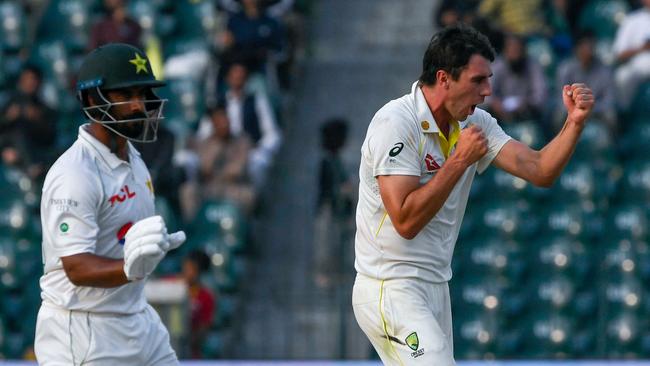Changing climate: Game is warming to Baggy Greens
No matter what happened on the last day of the Benaud-Qadir series two images will sum up Australia’s first trip to Pakistan in 24 years.

No matter what happened on the last day of the Benaud-Qadir series two images will sum up Australia’s first trip to Pakistan in 24 years.
The first was Pat Cummins on his knees in the dust, fist clenched, blue eyes blazing with passion after pulling off a remarkable caught and bowled to dismiss Azam Ali. Third day of a grinding Test match. Second half of the afternoon session. Bowling a futile and fruitless exercise.
It seemed an over reaction.
Pakistan had been reduced to 3-215, but the pitch was doing nothing, the second new ball had been taken and at this rate the game was due to conclude sometime in June.
It was as if Cummins, rarely given to shows of emotions, had been possessed by a spirit.
The side had bowled 87 overs and taken just three wickets, but he urged them like a Pentecostal pastor to believe that the rapture was upon them.
This prophet was not speaking in (forked) tongues. Lo and behold, not too long after, the trumpets sounded, the middle order opened and the opposition was stunned.
Pakistan, as we all know, lost 7-20 and there was hope for a tribe lost in a desert of dry gulch pitches for 14 days, trapped in a bubble for 40 nights.
Watch every match of the ICC Women’s Cricket World Cup LIVE & FREE on Kayo Freebies. Join free now and start streaming instantly.
On the fourth day of the deciding encounter Simon Katich observed that Cummins had to make the most important decision of his brief tenure as captain.
When to declare? Too early and he’d be condemned. Too late and he faced the same fate.
Returning to Pakistan after 24 years has been the greatest public relations campaign Australian cricket has had in living memory.
On the international stage — where the administration have been as mean of spirit in its dealings as many of the past teams have been in the way they play — Australian cricket has set a benchmark. The players too have embraced an ambassadorial role.
The spirit of cricket palaver some marketing man came up with some years back was hollow and unbelievable.
Words without substance. When push came to shove the Australian teams were all up for a push and a shove. They weren’t alone in that, but the Brendon McCullum’s Kiwis walked the talk and were mocked for it in these parts. The team and the administration have, at long last, taken a higher road.
Nothing short of a fist fight and an early flight home will take away from the fact that Australia stepped up and made the trip to Pakistan when none of the other major nations would play Test cricket here.
The fact they did it so soon after the New Zealand side absconded and the England side refused to honour its commitments (something Australia had a long track record of doing) has earned them a place in the heart of this cricket loving nation.
Pakistan has forgiven the fact that Australia was the first to object and the first to abandon it in its time of need.
The other image that will live long from this series is that of David Warner and Shaheen Shah Afridi breaking out in smiles after an exchange at the end of the third day. Actually, make that a couple of images.
The photo the pair took later when the Pakistan bowler had the diminutive batsman in a good natured headlock was sweet, but the handshake they shared when Warner was dismissed the next day was genuine. It reflected the spirit of this series.
Warner is a remarkable cricketer. The mob have always distrusted him and some have permanently hardened their hearts against him (hearts well hardened beforehand one suspects), it’s also fair to say cricket has consistently underrated him.
When he debuted for Australia as a T20 cricketer without having played a first-class match he was the devil incarnate for traditionalists. The hood ornament on the game’s gauche new vehicle.


He scored 89 incredible runs from 43 deliveries at the MCG against a South African attack which included bowlers of the class of Dale Steyn.
Here, they thought, was the game’s first mercenary man.
One attracted to the bling, the hit and giggle, one who measured himself by the length of his sixes and the money he made.
Warner told us all he wanted to wear the baggy green and again it sounded like the trite lines wheeled out for the crowd, but it turns out it was true.
Suspension and Covid have slowed his advance toward 100 games, but at 35 he is playing his 94 Test and he will not be satisfied until he brings up three figures.
He has three children, he has a wife he loves, he has a smile on his face and he has made the most of a second chance after being hounded from the game and the leadership roles he craved for what happened in South Africa.
Warner ranks eight among Australia’s highest run scorers (7753) in Test cricket. In the hardest batting position, a place where he is dreadfully exposed on seaming English wickets, he has l managed to average 47 runs across 172 innings. Mark Taylor sits below him with 7525 at 43.5 from 186.
Men can change, teams can change, times can change, it is time this climate of change was recognised.







To join the conversation, please log in. Don't have an account? Register
Join the conversation, you are commenting as Logout